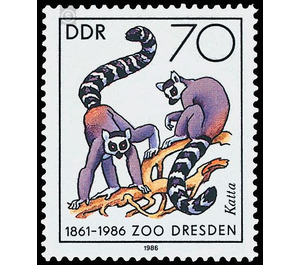125 years of dresden zoo - Germany / German Democratic Republic 1986 - 70 Pfennig
Theme: Animals
| Country | Germany / German Democratic Republic |
| Issue Date | 1986 |
| Face Value | 70.00 |
| Color | multi-colored |
| Perforation | K 14 |
| Printing Type | offset |
| Stamp Type | Postage stamp |
| Item Type | Stamp |
| Chronological Issue Number | 2764 |
| Chronological Chapter | GER-DDR |
| SID | 225981 |
| In 16 Wishlists | |
125th anniversary of ZOO Dresden On the occasion of the 125th anniversary of the zoological garden in Dresden, the Ministry of Posts and Telecommunications of the German Democratic Republic publishes four multi-colored special postage stamps. Special Cancellation from May 27 to July 26, 1986 125 Years of the Dresden Zoo Ever since the opening of the Dresden Zoo in 1861, monkeys have been introduced, and the first ape came to the zoo in 1873. Even today, this is the oldest zoological garden in the GDR as a "primate zoo", d. h. that in particular half-monkeys, animal monkeys and apes characterize its livestock. In the history of the Dresden zoo, two directors have made a name for themselves, especially through their publications on the orangutan biology. Gustav Brandes and Prof. Dr. med. Wolfgang Ullrich. It is thanks to their findings that today the breeding of these imposing apes, which are threatened with extinction in the wild, is no longer uncommon in many zoos. The zoological garden of Dresden has set itself the task to obtain by continuous breeding of several species of monkeys some representatives of the rare in the natural habitat of relatives of man to posterity. Four monkeys, which are exhibited in the Dresden Zoo and have already been bred, show the motifs of the present stamp series for the 125th anniversary of the zoo. 70 Pfennig value: Katta (Lemur catta) Kattas are of all half monkeys for the Tiergärtner so attractive exhibits, since it is very lively, diurnal Makis from Madagascar. All other members of the genus also live on the island of Madagascar, with its many living fossils, zoological treasures and unique habitats. No progressive primates came here, but no predators, which could be dangerous to primeval fauna. Only humans brought with its domestic animals, pests and civilization consequences danger for the unique Malagasy fauna, in particular the rare Halbaffenarte. Of all species, the kattas are still most frequently represented in the zoological gardens outside Madagascar. For some time now, the zoo in Dresden has bred these pretty, black-and-white-gray-drawn makis with their curled tails, which - erect - serve as a signal for attention. Kattas usually give birth to twins who "ride" on their mothers for about half a year. In the hordes of about 20 animals there is a fixed ranking in which dominate the young leading females and which is always stabilized with the help of very variable sounds and territorial scent marks, as the males often change the groups.


